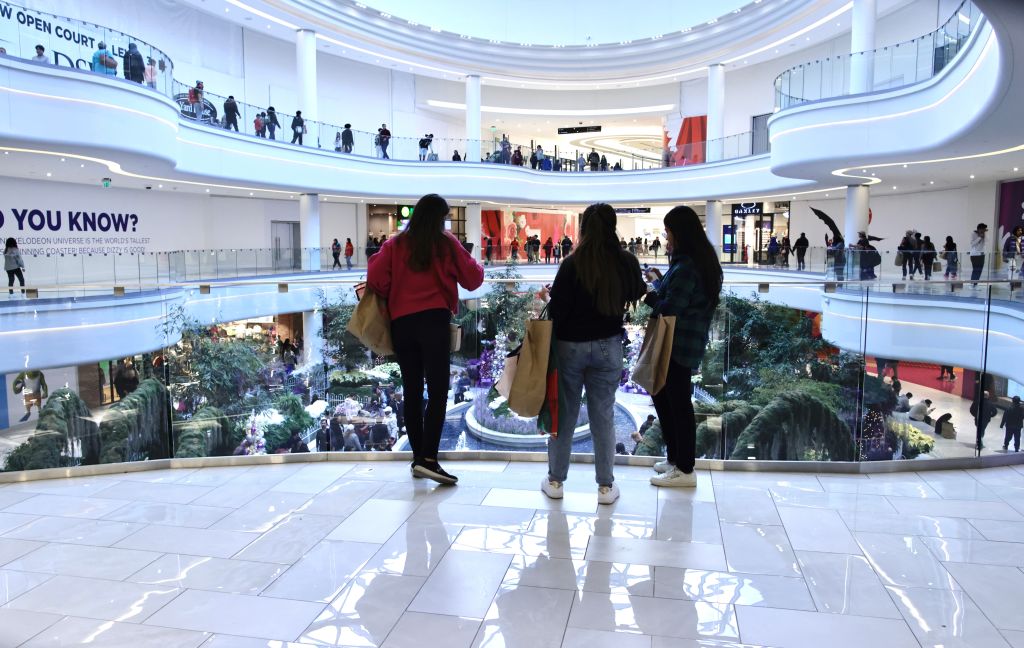
U.S. retailers discounted heavily on Black Friday to clear out bloated inventories but customers responded with only modest traffic, leaving profitability in doubt for many chains.
Crowds were thin in the late morning at Connecticut’s Stamford Town Center mall, with few shoppers at Kay Jewelers and just a small line at Forever 21. A couple at a Walmart Inc. supercenter near Dallas reveled in the lack of crowds as they bought presents for their grandchildren. At the Stonestown mall in San Francisco, shoppers were few and far between.
“It feels like a normal day,” said Miguel Martinez, 35, a warehouse supervisor walking through a Target Corp. store on Chicago’s North Side with his 12-year-old daughter, Jaylen. Martinez said he’s been cutting back on cable TV and Netflix to afford presents for his four children. He described the Black Friday discounts as “pretty good” as he picked up a couple of Amazon Echo Dot speakers, Nerf guns and a Disney Encanto doll.
U.S. consumers are still spending, but they’re growing more cautious after contending this year with the highest inflation rates in four decades. They’re also keeping a sharper lookout for deals, and retailers — many of them still heavy with inventory after misjudging an erosion in demand — are trying to stand out by dangling the deepest discounts since before the pandemic.
Modest Growth
The US holiday shopping season is likely to see modest to break-even growth in annual sales, said Melissa Minkow, director of retail strategy at digital consultancy CI&T. “That’s still a win,” she said, contrasting the outlook with the UK, where high inflation has caused consumers to pull back noticeably on spending. Still, the steep Black Friday discounts are likely to squeeze retailers.
“Profits will not be where retailers want them to be,” Minkow said. That’s in part because they “couldn’t pass all of the inflationary costs off to consumers.”
Read more: Bloomberg tracks Black Friday across the country
E-commerce spending on Black Friday rose 2.3% to $9.12 billion, according to Adobe Analytics.
That’s far less than the US inflation rate of almost 8% during the 12 months ended in October. Salesforce Inc. said the average consumer discount on Black Friday was expected to be greater than 30%, up from 28% last year and close to the 33% rate in 2019. The biggest discounts were in home appliances, apparel and health and beauty.
But shoppers are cutting back in reaction to higher prices, said Rob Garf, Salesforce’s vice president of retail.
“People are just plainly buying less products because their dollar isn’t going as far as it used to,” Garf said.
Lonely Middle
At Crossgates Mall in Albany, New York, low-cost brands and higher-end buzzy retailers had the most foot traffic, while the middle-market stores were desolate.
Gap Inc.’s Old Navy, which was offering 60% off most items, had a line so long that some shoppers turned around as soon as they entered the store.
Drawing big crowds at the higher end were athleisure favorite Lululemon Athletica Inc., which had only a few racks of discounted merchandise, and American Eagle Outfitters Inc.’s Aerie, a popular intimates brand among Gen Z shoppers. Meanwhile, stores like Gap’s Banana Republic, Macy’s Inc. and Urban Outfitters Inc. had no lines at all, and only a handful of shoppers.
The healthy traffic at some retailers shows that many US consumers are still spending at a robust clip. A crowded Best Buy Co. store near Dallas-Fort Worth International Airport had half a dozen cars pulled up by the door to pick up large televisions and other electronic goods. Grapevine Mills, a nearby discount mall, was so crowded that Shawanda Miller threw up her hands and left.
“I don’t even want to talk about it, it was so crowded in there,” said Miller, 43. “I’m going to come back another day.”
No Wait
But crowds like that appeared to be an exception. The checkout line at the toy section at a Macy’s in Stamford, Connecticut, had no wait and the cashier said the store had prepared for more shoppers. A Walmart in suburban Dallas also had cashiers standing at the ready with no lines, which was just fine with Veronica Gonzalez and Carlos Garcia, a couple visiting from Corpus Christi, Texas.
“What’s good about it is you don’t have to come in at 5 o’clock in the morning, and everything is here that we’re looking for,” Gonzalez said. Garcia said “everything’s for the grandkids” as he pushed a shopping cart full of bed sheets, suitcases and toys.
The era of Black Friday crowds came to a halt with the pandemic, and it probably isn’t coming back as more consumers shop online and spread their spending out over a longer period. “The historic raucous atmosphere of Black Friday may be in the past,” Edward Yruma, a retail analyst at Piper Sandler, said in a report.
Behind the moderate crowds are people such as Therese Pociask, 60, who was shopping at Target in Chicago for her small day-care center. She was also looking for gifts for her nieces and nephews. In her cart were an Epsom-salt gift pack, Fujifilm Instax camera film, three stuffed dinosaurs and a puzzle.
Pociask said she’s planning to spend about $2,000 during the holidays — about the same as last year. But with inflation high, her money isn’t going as far as it did.
“I’m trying to stay within my budget, but I’m finding I have to spend more for it to look the same,” she said.
More Must-Reads from TIME
- Cybersecurity Experts Are Sounding the Alarm on DOGE
- Meet the 2025 Women of the Year
- The Harsh Truth About Disability Inclusion
- Why Do More Young Adults Have Cancer?
- Colman Domingo Leads With Radical Love
- How to Get Better at Doing Things Alone
- Michelle Zauner Stares Down the Darkness
Contact us at letters@time.com